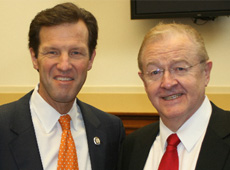So, where did it all go wrong for the SDLP?
Posted By: January 12, 2019
Under the leadership of John Hume, the SDLP encouraged Sinn Féin and Gerry Adams into the political mainstream throughout the 1980s and 1990s. A factor in the SDLP’s long decline was its failure to fully recognize Sinn Féin’s political intentions
Patrick Murphy. Irish News.Belfast. Saturday, January 12, 2019
So farewell then, the SDLP, primary advocate of power-sharing, lead architect of the Good Friday Agreement and once the darling of Washington.
Now a mere shadow of its former self, the party is split as it inches towards a possible merger with Fianna Fáil.
“How the mighty have fallen” might seem appropriate, but in the case of the SDLP, it may be more accurate to marvel at how the mighty threw themselves, lemming-like, off a political cliff.
Through political naivety, complacency, denial and a remarkable tendency to freeze in Sinn Féin’s headlights, the party has been destined to disappear for a decade.
When this column suggested an alliance with Fianna Fáil a few years ago, in the absence of the party moving to the left, the reaction was less than supportive. The party has been slow to grasp the reality of its situation.
So where did it all go wrong? The SDLP’s story contains political mistakes at the beginning, the middle and the end.
It began in 1970, through an amalgamation of Republican Labor, Northern Ireland Labor, some independents and Austin Currie of the Nationalist Party.
Although the party claims to have grown out of the Civil Rights Movement, it might be more accurate to say that it grew into a nationalist political vacuum, which developed for two reasons.
The first was that the Nationalist Party had been rendered irrelevant by the civil rights campaign.
The second was the newly emergent Provisional IRA’s failure to extend its politics beyond ‘Brits out’; they never specified who the Brits were, but it turned out they were English politicians and Irish Protestants.
The Civil Rights Movement regarded the new party as political opportunists since a Catholic party for a Catholic people was unlikely to further the cause of non-sectarian civil rights.
That political direction would punish the SDLP 30 years later.
The party’s middle period mistake was its political analysis at the time of the ceasefire when the IRA’s policy changed to ‘Brits in.’
The SDLP argued that the way to tackle sectarianism was to institutionalize it – and that’s when its wheels began to come off. London would look after the Protestants and Dublin would care for the Catholics.
That was perhaps the biggest blunder in modern Irish history, on a par with Hugh O’Neill surrendering to Elizabeth I, six days after she had died in 1603. It was a Catholic rather than a nationalist analysis, which perfectly matched the IRA’s classification of Irish Protestants as British.
The SDLP’s two-nations approach gave the IRA’s campaign a retrospective political relevance, placing Sinn Féin at the center of the sectarian stage.
From then on, the sectarian elite would rise to the top and, to the SDLP’s credit, it was never going to be one of our most sectarian parties.
The SDLP’s final mistake was its failure to recognize Sinn Féin’s political intentions.
From the mid-1980s, Sinn Féin was seeking advice on a vast range of political topics, including the concept of civil rights – and now we know why. When asked about their motive, the reply was, “You have seen nothing yet.”
The SDLP should have seen Sinn Féin coming. In bringing the IRA into the political arena, the SDLP was knocking on an open door.
Ironically, the party which identified a new political era in the 1970s collapsed because of its inability to recognize another new era in the 1990s.
When the SDLP was later sidelined in the Stormont executive by Sinn Féin and the DUP, it should have gone into opposition – another of this column’s proposals which received significant criticism.
The party finally entered opposition in 2016 and brought down Stormont, by exposing Sinn Féin and the DUP’s sectarian carve-up of power and patronage. It came too late to rescue the SDLP, but the party still deserves credit for its decision.
It is not clear what the possible political union with Fianna Fáil will be called, but it will effectively be the Not Sinn Féin Party. Its success level will depend on its branding and management.
Certainly, there is an electoral market for non-Sinn Féin nationalism, as evidenced by Sinn Féin’s involvement this week in the carve-up of the £500,000 ‘bonfire diversion’ fund in Belfast before applications were received and its refusal to debate the scandal of the Social Investment Fund.
But the likely new party now has the disadvantage of having to compete with Peadar Tóibín’s recently formed Definitely Not Sinn Féin party.
It will cover much of the same political territory as the SDLP-Fianna Fáil likely merger, which may have come too late.
If so, history may show that the SDLP’s fourth mistake was its last.










